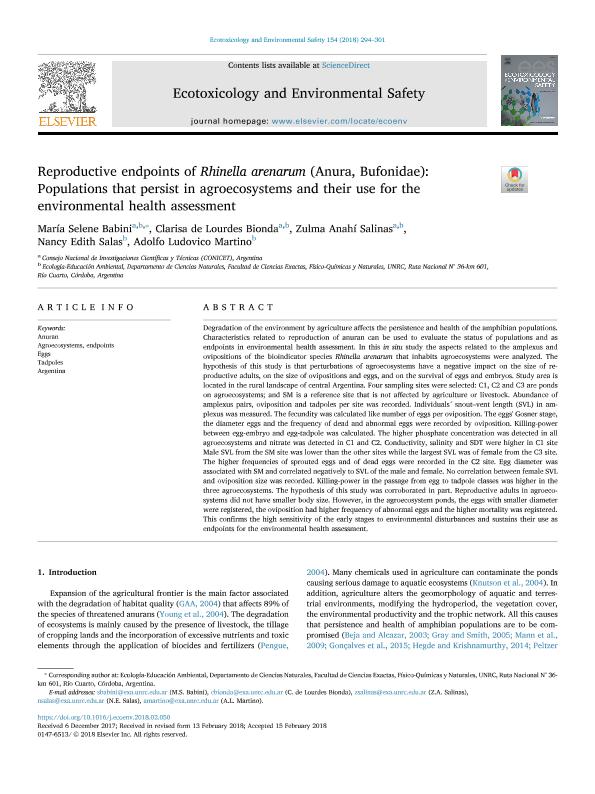Mostrar el registro sencillo del ítem
dc.contributor.author
Babini, María Selene

dc.contributor.author
Bionda, Clarisa de Lourdes

dc.contributor.author
Salinas, Zulma Anahí

dc.contributor.author
Salas, Nancy Edith

dc.contributor.author
Martino, Adolfo Ludovico

dc.date.available
2021-06-07T03:13:39Z
dc.date.issued
2018-06-15
dc.identifier.citation
Babini, María Selene; Bionda, Clarisa de Lourdes; Salinas, Zulma Anahí; Salas, Nancy Edith; Martino, Adolfo Ludovico; Reproductive endpoints of Rhinella arenarum (Anura, Bufonidae): Populations that persist in agroecosystems and their use for the environmental health assessment; Academic Press Inc Elsevier Science; Ecotoxicology and Environmental Safety; 154; 15-6-2018; 294-301
dc.identifier.issn
0147-6513
dc.identifier.uri
http://hdl.handle.net/11336/133282
dc.description.abstract
Degradation of the environment by agriculture affects the persistence and health of the amphibian populations. Characteristics related to reproduction of anuran can be used to evaluate the status of populations and as endpoints in environmental health assessment. In this in situ study the aspects related to the amplexus and ovipositions of the bioindicator species Rhinella arenarum that inhabits agroecosystems were analyzed. The hypothesis of this study is that perturbations of agroecosystems have a negative impact on the size of reproductive adults, on the size of ovipositions and eggs, and on the survival of eggs and embryos. Study area is located in the rural landscape of central Argentina. Four sampling sites were selected: C1, C2 and C3 are ponds on agroecosystems; and SM is a reference site that is not affected by agriculture or livestock. Abundance of amplexus pairs, oviposition and tadpoles per site was recorded. Individuals´ snout–vent length (SVL) in amplexus was measured. The fecundity was calculated like number of eggs per oviposition. The eggs’ Gosner stage, the diameter eggs and the frequency of dead and abnormal eggs were recorded by oviposition. Killing-power between egg-embryo and egg-tadpole was calculated. The higher phosphate concentration was detected in all agroecosystems and nitrate was detected in C1 and C2. Conductivity, salinity and SDT were higher in C1 site Male SVL from the SM site was lower than the other sites while the largest SVL was of female from the C3 site. The higher frequencies of sprouted eggs and of dead eggs were recorded in the C2 site. Egg diameter was associated with SM and correlated negatively to SVL of the male and female. No correlation between female SVL and oviposition size was recorded. Killing-power in the passage from egg to tadpole classes was higher in the three agroecosystems. The hypothesis of this study was corroborated in part. Reproductive adults in agroecosystems did not have smaller body size. However, in the agroecosystem ponds, the eggs with smaller diameter were registered, the oviposition had higher frequency of abnormal eggs and the higher mortality was registered. This confirms the high sensitivity of the early stages to environmental disturbances and sustains their use as endpoints for the environmental health assessment.
dc.format
application/pdf
dc.language.iso
eng
dc.publisher
Academic Press Inc Elsevier Science

dc.rights
info:eu-repo/semantics/openAccess
dc.rights.uri
https://creativecommons.org/licenses/by-nc-nd/2.5/ar/
dc.subject
AGROECOSYSTEMS, ENDPOINTS
dc.subject
ANURAN
dc.subject
ARGENTINA
dc.subject
EGGS
dc.subject
TADPOLES
dc.subject.classification
Ciencias Medioambientales

dc.subject.classification
Ciencias de la Tierra y relacionadas con el Medio Ambiente

dc.subject.classification
CIENCIAS NATURALES Y EXACTAS

dc.title
Reproductive endpoints of Rhinella arenarum (Anura, Bufonidae): Populations that persist in agroecosystems and their use for the environmental health assessment
dc.type
info:eu-repo/semantics/article
dc.type
info:ar-repo/semantics/artículo
dc.type
info:eu-repo/semantics/publishedVersion
dc.date.updated
2021-06-02T12:14:00Z
dc.journal.volume
154
dc.journal.pagination
294-301
dc.journal.pais
Países Bajos

dc.journal.ciudad
Amsterdam
dc.description.fil
Fil: Babini, María Selene. Universidad Nacional de Río Cuarto. Facultad de Ciencias Exactas Fisicoquímicas y Naturales. Departamento de Ciencias Naturales. Cátedra de Ecología; Argentina. Consejo Nacional de Investigaciones Científicas y Técnicas. Centro Científico Tecnológico Conicet - Córdoba; Argentina
dc.description.fil
Fil: Bionda, Clarisa de Lourdes. Universidad Nacional de Río Cuarto. Facultad de Ciencias Exactas Fisicoquímicas y Naturales. Departamento de Ciencias Naturales. Cátedra de Ecología; Argentina. Consejo Nacional de Investigaciones Científicas y Técnicas. Centro Científico Tecnológico Conicet - Córdoba; Argentina
dc.description.fil
Fil: Salinas, Zulma Anahí. Universidad Nacional de Río Cuarto. Facultad de Ciencias Exactas Fisicoquímicas y Naturales. Departamento de Ciencias Naturales. Cátedra de Ecología; Argentina. Consejo Nacional de Investigaciones Científicas y Técnicas. Centro Científico Tecnológico Conicet - Córdoba; Argentina
dc.description.fil
Fil: Salas, Nancy Edith. Universidad Nacional de Río Cuarto. Facultad de Ciencias Exactas Fisicoquímicas y Naturales. Departamento de Ciencias Naturales. Cátedra de Ecología; Argentina
dc.description.fil
Fil: Martino, Adolfo Ludovico. Universidad Nacional de Río Cuarto. Facultad de Ciencias Exactas Fisicoquímicas y Naturales. Departamento de Ciencias Naturales. Cátedra de Ecología; Argentina
dc.journal.title
Ecotoxicology and Environmental Safety

dc.relation.alternativeid
info:eu-repo/semantics/altIdentifier/url/https://www.sciencedirect.com/science/article/pii/S0147651318301428
dc.relation.alternativeid
info:eu-repo/semantics/altIdentifier/doi/https://doi.org/10.1016/j.ecoenv.2018.02.050
Archivos asociados
